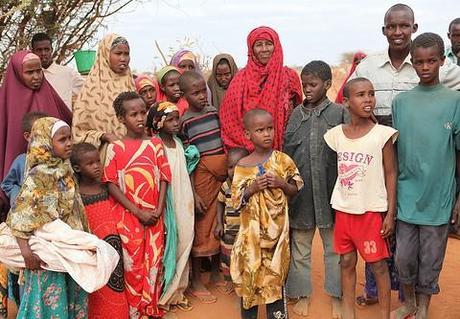
Families arriving at an aid camp in Somalia. Photocredit: Oxfam East Africa http://www.flickr.com/photos/oxfameastafrica/5936305120/sizes/m/in/photostream/
Drought has hit the Horn of Africa, affecting Kenya, Ethiopia and Somalia especially. These droughts have become more and more frequent: fifty years ago they happened every 10 years; now, since 2000 there have been three major droughts. Refugees are fleeing conditions debilitated by a civil war between al Qaeda linked organisation al Shabab, and the country’s Transitional Federation Government. Pastoralists’ livelihoods are in the balance – despite their resilience and ability to sustain droughts, other factors, including government orders, are driving them out. So why didn’t we see this coming, and what can be done about it?
- Why didn’t we go earlier? Climate change will make Africa “harder to live in in future,” said John Vidal on The Guardian. But it’s wrong to think that this is the only factor. “This is an entirely predictable, traditional, man-made disaster, with little new about it except the numbers of people on the move and perhaps the numbers of children dying near the cameras.” The crisis was not unexpected: there’s been no rain for two years in Somalia. But only now, with children dying and cattle sold, does the “global humanitarian machine” move in. “Why did it not go earlier?” War is the prime factor, with people losing assets and grazing grounds. Also, the government is steadily marginalising pastoralists, whose lifestyle is seen as “outmoded”. But these pastoralists produce “more and better quality meat and generate more cash per hectare than ‘modern’ Australian and US ranches.” The world must help these people to adapt to conditions. Aid will cost around $400 million. This money should be put into long term development. “Instead, the world is almost certain to be here again in one or two years’ time. Next time, though, there will be no excuses.”
- There must be a better system. Why was the famine warning system for Somalia (the Food Security and Nutrition Assessment Unit) not effective this time? asked Celia Petty and John Seaman on The Guardian’s Comment is Free. To be so, early warning has to meet three conditions: “who needs help, how much relief is required and when is it needed”. The problem is there are two approaches to warning. The first, “Integrated Phase Classification”, based on measures of “precipitation, crop production and food prices” is currently in use in Somalia, despite its unreliability, and despite having failed in Malawi (2002) and Niger (2005). But crop failure and famine aren’t directly connected. The alternative is the “Livelihood” approach. Based on detailed information about household economy, and developed from Nobel economist Amartya Sen, it helped Malawi to avoid famine in 2005 even after a crop failure. This crisis should not have been a surprise: the UN must provide a “full explanation.”
Read the report of the Food Security and Nutrition Assessment Unit
- Internal tensions. Gabe Joselow on Voice of America News asked whether the Somalia militant group al Shabab (which has links to al Qaeda) had been weakened by the famine. With the group split between jihadists, who are anti-foreign aid, and localists who are more welcoming, mixed messages have been sent out, with aid agencies first banned, then lifted, then allowed in again. This “internal weakening, and a loss of faith in al Shabab by the Somali people is tearing the group apart.” The Transitional Federation Goverment has announced a “successful operation” against al Shabab in Mogadishu, and the now claims to “control more of the capital city than ever.” But al-Shabab are still recruiting – the war is not over yet.
- Peanut butter saves the day. The World Food Program is airlifting food to Mogadishu, said Shots. The food “is a peanut-based paste called Plumpy’Sup or Supplementary Plumpy.” High in calories, easy to transport, full of proteins and minerals, and with a long shelf-life; its sweetness means children will eat it too. You don’t have to cook it, either: “A mom can tear a corner of the packet and feed it to her child right from the package.” Each 500-calorie pack is enough for a 10-month old, but older children will need more food. “This shipment isn’t expected to be the last. According to the United Nations, 80 more tons of food aid will be taken to Mogadishu in the next few weeks and 20 tons will be sent to the south of the country.” Meanwhile, said Reuters, the European Union has extended by a year its military mission to train Somalia’s security forces.

